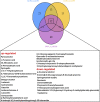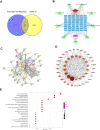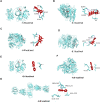Discovery of the key active compounds in Citri Reticulatae Pericarpium (Citrus reticulata "Chachi") and their therapeutic potential for the treatment of COVID-19 based on comparative metabolomics and network pharmacology
- PMID: 36506534
- PMCID: PMC9727096
- DOI: 10.3389/fphar.2022.1048926
Discovery of the key active compounds in Citri Reticulatae Pericarpium (Citrus reticulata "Chachi") and their therapeutic potential for the treatment of COVID-19 based on comparative metabolomics and network pharmacology
Abstract
Edible herbal medicines contain macro- and micronutrients and active metabolites that can take part in biochemical processes to help achieve or maintain a state of well-being. Citri Reticulatae Pericarpium (CRP) is an edible and medicinal herb used as a component of the traditional Chinese medicine (TCM) approach to treating COVID-19 in China. However, the material basis and related mechanistic research regarding this herb for the treatment of COVID-19 are still unclear. First, a wide-targeted UPLC-ESI-MS/MS-based comparative metabolomics analysis was conducted to screen for the active metabolites of CRP. Second, network pharmacology was used to uncover the initial linkages among these metabolites, their possible targets, and COVID-19. Each metabolite was then further studied via molecular docking with the identified potential SARS-CoV-2 targets 3CL hydrolase, host cell target angiotensin-converting enzyme II, spike protein, and RNA-dependent RNA polymerase. Finally, the most potential small molecule compound was verified by in vitro and in vivo experiments, and the mechanism of its treatment of COVID-19 was further explored. In total, 399 metabolites were identified and nine upregulated differential metabolites were screened out as potential key active metabolites, among which isorhamnetin have anti-inflammatory activity in vitro validation assays. In addition, the molecular docking results also showed that isorhamnetin had a good binding ability with the key targets of COVID-19. Furthermore, in vivo results showed that isorhamnetin could significantly reduced the lung pathological injury and inflammatory injury by regulating ATK1, EGFR, MAPK8, and MAPK14 to involve in TNF signaling pathway, PI3K-Akt signalling pathway, and T cell receptor signaling pathway. Our results indicated that isorhamnetin, as screened from CRP, may have great potential for use in the treatment of patients with COVID-19. This study has also demonstrated that comparative metabolomics combined with network pharmacology strategy could be used as an effective approach for discovering potential compounds in herbal medicines that are effective against COVID-19.
Keywords: COVID-19; Citri Reticulatae Pericarpium; Network Pharmacology; comparative metabolomics; isorhamnetin.
Copyright © 2022 Wang, Chen, Chen, Yan and Liu.
Conflict of interest statement
The authors declare that the research was conducted in the absence of any commercial or financial relationships that could be construed as a potential conflict of interest.
Figures












Similar articles
-
[Network pharmacology research on high frequency use of Pericarpium Citri Reticulatae and Aucklandiae Radix herb pair in treatment of constipation with aromatic traditional Chinese medicine based on data mining].Zhongguo Zhong Yao Za Zhi. 2020 May;45(9):2103-2114. doi: 10.19540/j.cnki.cjcmm.20200221.304. Zhongguo Zhong Yao Za Zhi. 2020. PMID: 32495559 Chinese.
-
[Spleen deficiency and phlegm dampness syndrome model in rats treated by Citri Reticulatae Pericarpium based on metabolomics].Zhongguo Zhong Yao Za Zhi. 2022 Aug;47(15):4136-4147. doi: 10.19540/j.cnki.cjcmm.20220218.701. Zhongguo Zhong Yao Za Zhi. 2022. PMID: 36046904 Chinese.
-
Discrimination of Citrus reticulata Blanco and Citrus reticulata 'Chachi' as well as the Citrus reticulata 'Chachi' within different storage years using ultra high performance liquid chromatography quadrupole/time-of-flight mass spectrometry based metabolomics approach.J Pharm Biomed Anal. 2019 Jul 15;171:218-231. doi: 10.1016/j.jpba.2019.03.056. Epub 2019 Mar 29. J Pharm Biomed Anal. 2019. PMID: 31072532
-
Citri Reticulatae Pericarpium (Chenpi): A multi-efficacy pericarp in treating cardiovascular diseases.Biomed Pharmacother. 2022 Oct;154:113626. doi: 10.1016/j.biopha.2022.113626. Epub 2022 Sep 1. Biomed Pharmacother. 2022. PMID: 36058153 Review.
-
Citri Reticulatae Pericarpium (Chenpi): Botany, ethnopharmacology, phytochemistry, and pharmacology of a frequently used traditional Chinese medicine.J Ethnopharmacol. 2018 Jun 28;220:265-282. doi: 10.1016/j.jep.2018.03.031. Epub 2018 Apr 6. J Ethnopharmacol. 2018. PMID: 29628291 Review.
Cited by
-
Comparison of the volatile organic compounds in Citrus reticulata 'Chachi' peel with different drying methods using E-nose, GC-IMS and HS-SPME-GC-MS.Front Plant Sci. 2023 May 17;14:1169321. doi: 10.3389/fpls.2023.1169321. eCollection 2023. Front Plant Sci. 2023. PMID: 37265640 Free PMC article.
-
Insights into metabolic characteristics and biological activity changes in Zangju (Citrus reticulata cv. Manau Gan) peel at different maturity stages through UPLC-MS/MS-based metabolomics.Food Chem X. 2024 Feb 5;21:101197. doi: 10.1016/j.fochx.2024.101197. eCollection 2024 Mar 30. Food Chem X. 2024. PMID: 38357370 Free PMC article.
-
Identification of South African Plant-Based Bioactive Compounds as Potential Inhibitors against the SARS-CoV-2 Receptor.Pharmaceuticals (Basel). 2024 Jun 22;17(7):821. doi: 10.3390/ph17070821. Pharmaceuticals (Basel). 2024. PMID: 39065672 Free PMC article.
-
A field survey on the dietary use of traditional Chinese medicine in selected regions with the Cantonese, Hakka, and Teochew populations in Guangdong province, China.Food Sci Nutr. 2024 Jul 24;12(10):7438-7448. doi: 10.1002/fsn3.4295. eCollection 2024 Oct. Food Sci Nutr. 2024. PMID: 39479612 Free PMC article.
-
Neofunctionalization of an OMT cluster dominates polymethoxyflavone biosynthesis associated with the domestication of citrus.Proc Natl Acad Sci U S A. 2024 Apr 2;121(14):e2321615121. doi: 10.1073/pnas.2321615121. Epub 2024 Mar 26. Proc Natl Acad Sci U S A. 2024. PMID: 38530892 Free PMC article.
References
LinkOut - more resources
Full Text Sources
Research Materials
Miscellaneous

